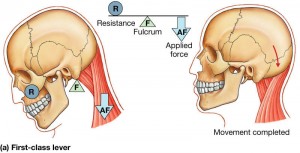- Acu Health Care | Wan YoonA1/16 Saturn place
Rosedale, Auckland 063202108695572 Clinic Hours
Mon:10am-8pmWed:10am-1pmThurs:10am-6pmSat:10am-1pm
-
- Acu Health Care | Wan Yoon1/35 Jervois Road
Ponsonby, Auckland 101102108695572 Clinic Hours
Wed2pm-6pmSat2pm-6pm
Uncategorized
Low back pain? It could be from your Pelvis!
So, you have been suffering from on-going low back pain for a number of years. You’ve tried this and that but nothing really helped much although you got some relief for a short period time. When the lumbar pain is persistent like that, it may not just be a low back problem. Have you gotten your pelvis checked?
I’d like to introduce the term “Anterior Pelvic Tilt” and “Posterior Pelvic Tilt” which are really important when it comes to the lumbar pain.
What is Anterior Pelvic Tilt?
When we sit a lot, our hip flexors (mainly rectus femoris & psoas major) shortens. If you have short hip flexors and stand up, your hip flexors will pull on the femur on one end and the hip, as well as the lumbar spine (lower back). This will cause the hip to tilt forward and the lumbar curvature to increase (excessive lordosis). Excessive lordosis puts lots of pressure on lumbar spine which can cause sore low back.
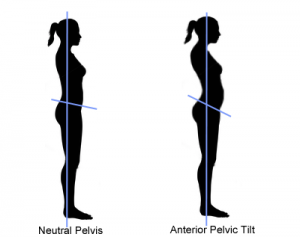

How to fix it?
Kneeling Hip Flexor Stretch
The kneeling hip flexor stretch targets your hip flexors. Begin in a kneeling position on the floor. Bring your left foot forward so that it is directly below your left knee. Both legs should be at a 90-degree angle. Lean forward into the hip while keeping your back straight and your pelvis from tilting to either side or forward. Hold the stretch for 30 to 45 seconds and complete the stretch two to five times. Repeat on the other side.

The Bridge
The Bridge targets your gluteals and hamstrings. Start by lying on your back with your knees bent and your feet flat on the floor. Place your feet hip-distance apart. Contract your abdominal muscles to press your back into the floor. Maintain your abdominals and spine in this position throughout the exercise. Lift your hips off the floor and toward the ceiling while pushing into your heels for stability. Your gluteals and hamstrings should be contracted and used to complete this action. Hold this position for 30 to 45 seconds, lower your body, and repeat three to five times. Alternately, you can perform a pulsing action of repeatedly pushing your hips up and lowering slightly.
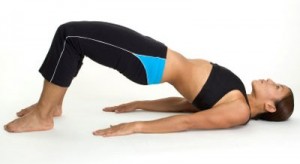
The Plank
The Plank is a full-body exercise that targets your abdominal muscles as well as your erector spinae. To complete this exercise, begin on all fours, with your palms directly below your shoulders. Move into a pushup position by bringing each foot back, engaging your abdominals and adjusting your feet as needed. Hold the pose for as long as possible, working up to 60 seconds or longer. Alternately, the exercise can be completed with your elbows on the floor directly below your shoulders.
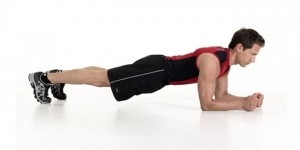
What is Posterior Pelvic Tilt?
When the front of the pelvis rises and the back of the pelvis drops. This happens when the hip flexors lengthen and the hip extensors shorten, particularly the gluteus maximus which is the primary hyperextensor of the hip. This causes straight back which doesn’t allow low back to absorb the shock efficiently so it can cause lumbar pain.

How to fix it?
Foam Roll
The first step to corrective exercise is foam-rolling and/or stretching the tightened muscles. To foam-roll the hamstrings, sit with the foam roll under the hamstring, applying as much pressure as you can handle. Hold each sore spot until the pain subsides (roughly 30 seconds). For the glutes: Sit on top of the roll, with one ankle resting on the opposite knee, lean toward the lifted leg, feeling for those tight spots. The abdominals cannot be foam-rolled but should definitely be stretched. After foam rolling, stretch the hamstrings and glutes to allow the muscles to return to their normal lengths.

Lunges
To keep the pelvis from reverting back to posterior pelvic tilt, some strength exercises are required. Corrective exercises should include those that require the hamstrings, glutes, and quads to work synergistically rather than allowing the hamstring and glute dominance to continue. One example is the lunge. Lunges are particularly good because they break the work into two separate legs, allowing for even more focus on the correct muscle group. There also tends to be a bit of focus on the weakened quadriceps and hip flexors. To do a lunge, take a long stride with either leg forward. Keep your weight evenly distributed and lower your weight until both knees are bent at 90 degrees, then return to the starting position. Repeat the same number of repetitions on each leg.
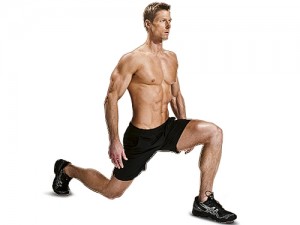
Superhero
The lower back muscles also need to be strengthened since they too are a part of the weakness that allows posterior pelvic tilt to be a problem. Any exercise involving spinal extension will help to strengthen the muscles of the lower back. One of the simplest and most effective is the superhero: Lie face down on the floor with arms extended out in front of you. Slowly, lift the arms and legs off the ground simultaneously (like a superhero during flight). Lower, and repeat for the desired repetitions.
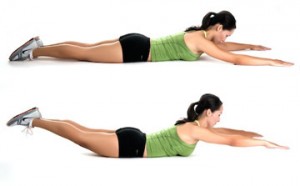
What causes the Neck pain?
In my practice, about 7-8 people out of 10 have stiffness or pain in their neck. It’s not difficult to discover the neck issue even if they came for some other problems. Too much use of computer, stress, bad postures,etc contribute sore neck. Let’s look at the simple muscle lever system on the neck.
As you see above, AF(applied force) should be applied to sustain R(resistance). That means when there is more Resistance, the stronger AF should be applied otherwise the head will drop. That’s why the back of your neck gets tight (AF) when you spend long hours looking at the computer screen or playing with your phone with your head pushed low and forward (R).
Now let’s look at the primary muscle that controls the neck flexion.
Sternocleidomastoid (SCM)

You can easily see and palpate this muscle when you turn your head to the either side. When this shortens,it pushes your head forward (more Resistance).
What can we do?
Simply massage SCM muscle and do the stretch shown below will help you correct the slouched posture. You can do this as often as possible throughout the day. I recommend you to set the timer on your mobile every 20 – 30 mins so you won’t forget to do your stretch.

